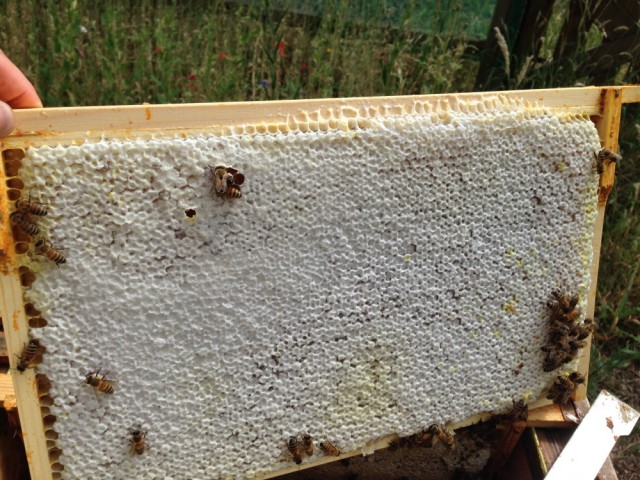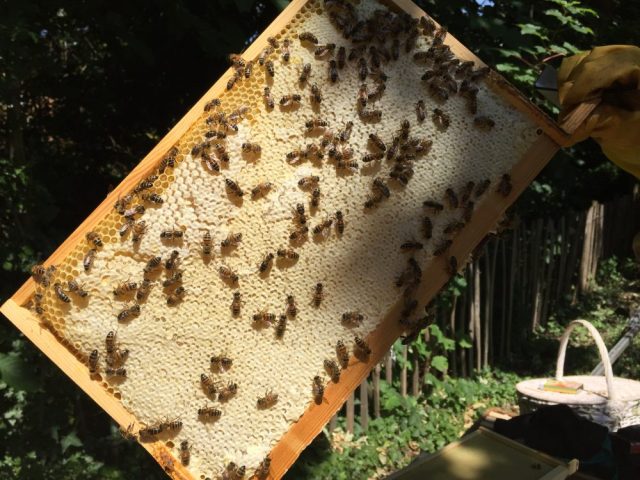At the weekend I heard Tony Harris, a Scottish bee farmer, give two talks at the annual Cornwall Beekeepers Association/West Cornwall Beekeepers Association ‘Bit of a Do’ conference. Here are my notes from his talk, which had plenty of jokes along with plenty of great tips.
Obviously Scotland is a looong way up from Cornwall, so Tony reckons his hives in the Moray Firth are about two months behind ours. After going up to 150 hives last summer and nearly killing himself running around after them all, this summer he’s reduced his operations down to 70 hives. He needs honey for money, so here’s his advice on how to get it.
- You need a plan – write it down
- You need the right bees – young queen, strong colony. More than 1 queen per hive helps!
- Rigorous management – regular inspections
- Swarm prevention and control (more on that later)
- Apiary location – know your forage! And think about the numbers of hives, not just in your apiary but locally.
Some general tips
- Keep strong colonies – build up large colonies before the main summer flow
- Check stores in winter
- Replace 1/3 of your brood combs per year – consider the ‘shook swarm’ method to do all your brood combs in one go in spring
- Cull poor queens
- Carry out integrated pest management for varroa all season, monitor!
- After you’ve dealt with swarming and have seen the new queen is laying, relax inspections. Let them get on with it.
- Build up a store of drawn comb for supers. You can keep using super comb for years and years.
- Tony doesn’t mark his queens the year they emerge, as he’s had them balled by the bees if he marks too early. Instead he waits for the following spring – easier then too, as there’s less bees in the colony come spring.
Tips for finding queen
- Use minimal smoke
- Do not be distracted, have a one-track mind on finding her
- Go straight to the middle brood frames and examine the ‘dark side’ of frames first as you lift them out.
- Last resort – use the wine method! (This would be when you phone up your best beekeeping buddy and offer them a bottle in return for them finding her majesty).
Getting foundation drawn
- Tony does a lot of ‘chimneying’. This involves putting an empty large poly brood box full of foundation over a colony in a poly nucleus, and feeding. He will quickly have a box full of drawn out foundation.
Tony’s main honey crops
- Oilseed rape (OSR) – harvest May/June
- Main summer – harvest August
- Ling heather – harvest September
He takes colonies to OSR in mid-April, puts three supers on at once, then goes on holiday for a week. Then comes the hard part – “If you’ve got a nice job you enjoy don’t even think about being a bee farmer”. After returning from holiday he extracts the oil seed rape honey fast, as otherwise it sets like rock extremely quickly. He will extract 10 supers a day, in 16 hour shifts. Starting in the early morning, working through to 10pm at night, having a shower, then starting again the next morning. Hot, heavy, sweaty work.
Part of the skill of being a bee farmer is keeping strong colonies, which means avoiding having swarms. Tony uses a much more proactive form of swarm control than me, which I was intrigued by. He’s found that making up nucleuses is the easiest method for him. He removes 1,2,3 or 4 frames from a colony in spring to delay its swarm preparations. He then puts foundation in the middle of the boxes the frames are taken from – as he noted, contrary to what beekeeping books will tell you!
The removed frames are used to make up 5-frame nucs: 2 frames of honey/pollen, at both ends, 2 frames of eggs/larvae, 1 frame foundation, plus bees shaken in. So instead of waiting for queen cells like I do, he effectively forces the bees into an early swarm, making their new queens in the nuc instead. I’m interested in trying this out, as what with work, a young family and having my bees at an out-apiary, it can be challenging keeping up with all the swarms down here!
My next blog post will be notes from Dr Ben Woodcock’s talk on “Neonicotinoid pesticides and bees”.



Intrigued to see that you will be reporting on Ben Woodcock’s talk. I taught him when he was an undergraduate at Imperial College, and then he did his PhD with me 🙂
LikeLike
Ah fantastic! You will probably be familiar with the research he talked about already then. It was a surprise to me to hear that oil seed rape may soon become uneconomic in some parts of England and farmers are likely to switch to new crops.
LikeLike
There has been a decline in OSR planted area yes.
LikeLiked by 1 person
Interesting to read how a professional beekeepers manages his hives. I thought looking after 12 hives, while also working, was hard work, let alone 170!
I will be interested to read the next post, the NFU always said that growing OSR would become uneconomic without the sprays to control the beetle. It will be interesting to see what crop they replace it with, OSR is a relatively new crop in the UK, being only grown for the last 40 years following EU subsidies to encourage the oil production.
LikeLike
Well, to be fair Tony’s sole job (as far as I can tell!) is being a honey farmer, he’s not doing another job on the side too! But yes it must be incredibly hard work.
By the sounds of it alternative crops to OSR may not be as bee-friendly and could be wind pollinated crops instead. So will losing neonics actually leave bees worse off, if there’s much less forage about as a result? Ben thought planting more wild flower borders could be a solution… but will farmers be prepared to do that?
LikeLike
Lots of interesting points. The bees must be busy in the Moray Firth given the short period of warm weather. I ‘m intrigued that the beekeepers around here are surrounded with OSR and no-one manages to put three supers on. Different variety, not enough rain here – who knows?
LikeLike
That is interesting isn’t it. Tony did say that he was lucky to have relatively few beekeepers in his local area, so there’s not too much competition for the OSR. He also mentioned the Moray Firth having its own relatively sheltered micro-climate. By the sounds of it the OSR is his most reliable crop, as he said he’s taken the bees to the heather before and come back empty handed.
Do you know whether the hornet has affected how much honey beekeepers close to you get?
LikeLiked by 1 person
The Moray Firth is reasonably sheltered but I suspect it’s colony strength that is the determining factor … in my experience commercials run their colonies significantly stronger than most amateurs.
LikeLike
The hornets are just starting to build up at this season. Last year we heard a lot of complaints from our local union, However, it is more that they weaken the colonies from now on when they should be securing winter supplies and winter bees, this leads to colonies not surviving the winter. There were heavy losses last winter. So it is not directly affecting honey production. However, you are not starting off in the springtime with strong colonies and this would indirectly effect spring honey collection. The sunflower honey has been very poor because the sunflowers were very poor and dried up with the heat and drought. Amelia
LikeLike
I see. What a shame about the sunflower honey. I’ve also heard in talks before that sunflower pollen is not very nutritious for bees.
LikeLike
We have heard that it has a lower protein content but the bees have lots of other choices for pollen when the sunflowers are out. They usually bring in a variety of colours. The honey is very yellow if it is mainly sunflower, so it is easy to see what you have got.
LikeLike
Thank you, so much, Emily x
LikeLike
You’re welcome – was glad I could go to the talk x
LikeLike
A big strong lad like Tony should be able to extract more than 10 supers a day. Even a wimp like me can get through 16, though that doesn’t include cleaning up the mess afterwards 😉 Maybe he should invest in an electric extractor?!
Cheers
David
LikeLike
He must be doing the crush and strain method, one frame at a time 😉
LikeLike
Very helpful post. Thank you. Next year I want to try his method for swarm control. We struggled this year because we had so many swarms. The weather was rainy when the queens needed to mate, so we were really set back.
LikeLike
Hi Emily; it’s a while since I commented and hope you’ll forgive this. A recycling friend of mine received this from a recycling/re-use blog and the romantic in me wanted to help and thought you were a natural choice as you may know more in the London area: Someone called Craig posted on chitchat: “This may sound really Cheesy but I really need your help I lost contact with the love of my life she never new because I never had the chance to tell her I think about her everyday and have tried social media site search but haven’t got far her name is Danielle Williams from Thanet I no she was keeping bees and part of the bee community if any one no’s her can you point her in the right direction I need to let her no thank u”
LikeLike
Hiya – Thanet seems to be in Kent is it? A long way from my old part of London but I did a google and wondered if this could be the Danielle, she has done tweets about Thanet and bees – https://twitter.com/simply_me_xx ?
LikeLike
Fascinating!
LikeLike